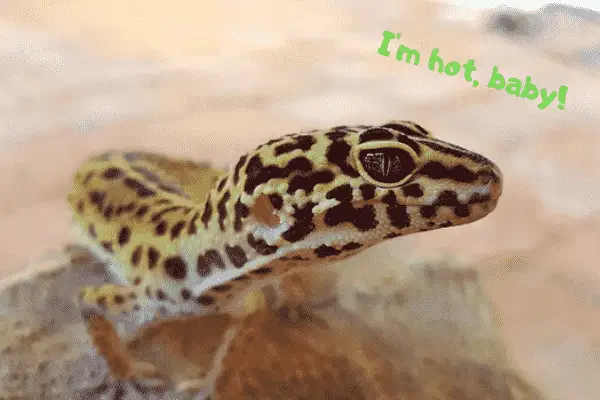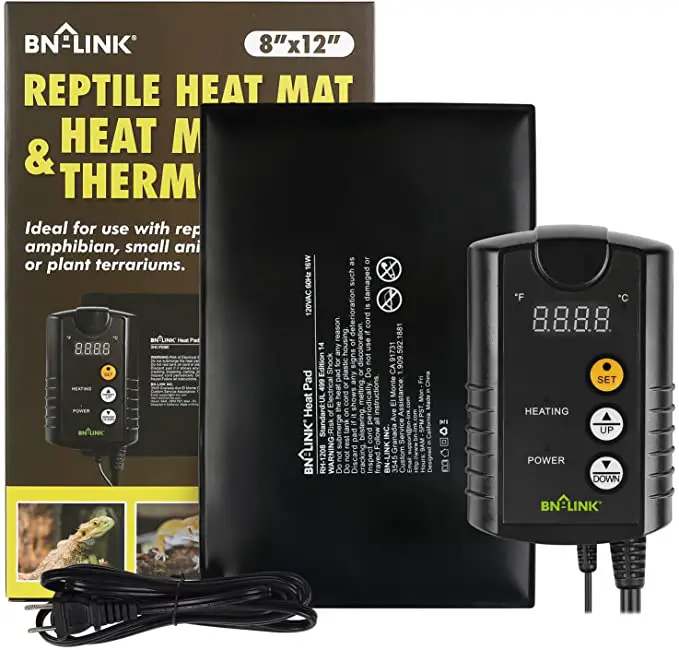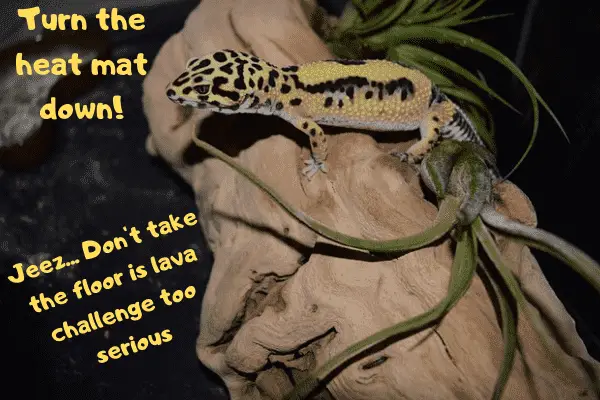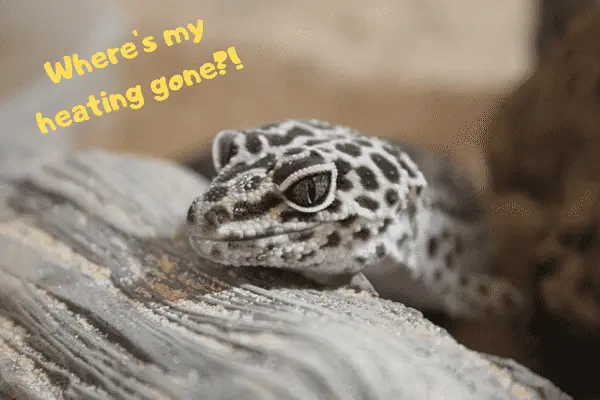When it comes to leopard geckos there’s not much that’s more important than the heating provided in their enclosure. A leopard gecko’s temperature isn’t regulated on the inside like it is with us humans which makes it vital to their survival.
Reptiles are cold-blooded, so a leopard gecko’s temperature is altered by the environment. If they’re not provided with enough opportunity to warm up, then various bodily functions, like digestion, start to fail.

However, this does bring up some questions.
- What temperature should my leopard gecko enclosure be?
- How should my leopard gecko’s enclosure be heated?
- Is it best to heat a leopard gecko enclosure from below or above?
In this post, we’re going to cover these questions, and more!
Want to learn everything there is to know about leopard gecko care? Our leopard gecko care guide is a good place to start!
Table of Contents
Does my leopard gecko need heating in its enclosure?
Yes. Leopard geckos are mostly active in the early morning and late at night. In the wild, they aren’t usually in direct sunlight for a lot of their life.
Leopard geckos absorb heat from the rocks and sand they walk on. These rocks and sandy patches get very hot during the day where they live and maintain their temperature for a long time.
This is the main reason why you need to provide heating from underneath, and not from above. Lamps can work, but it’s still advised to use a heat pad too. Even if you live in a warm place, you won’t be able to create a heat source that heats up the floor as a heat pad or lamp does. We recommend this heat pad from amazon , it has great reviews and has a visible digital temperature dial.

Why do leopard gecko’s need heating?
Leopard geckos aren’t like a lot of reptiles. Unlike most, they don’t need the UV rays or added vitamin D from the sunlight (or heat lamp). This helps most reptiles to digest their foods and absorb calcium properly. Since Leos aren’t normally active during the day, this isn’t an issue for them.
Leopard geckos use heat from underneath them to heat up their bellies in order to digest their diet of crickets and mealworms. Without sufficient heating from underneath, your leopard gecko can suffer various health conditions, and eventually pass away.

How should I heat my leopard gecko enclosure?
Heating your leopard gecko enclosure comes with a few instructions. There are also a lot of different opinions regarding heating a leopard gecko enclosure, many of which we’ll touch on briefly here.
Some swear by the heat lamp, while others advocate heat mats. In reality, it doesn’t really matter which method you use, as long as it’s safe for your leopard gecko and provides enough heating.
Tip: Don’t heat your leopard gecko enclosure using a heat-rock. Even though these heat rocks can work fine, there is no layer of insulation on top of it. Also, there are often points on the rocks that get hotter than others.
The chances of your leopard gecko getting burns from rocks like this are quite high. Also, they usually won’t provide a large enough area for your gecko to thermoregulate.
Personally, I used a heat mat for my leopard gecko. Generally, this is what’s going to give the best results without having to constantly monitor their enclosure (we recommend this heat mat)
Using a heat mat is simple and will ensure a constant “hot-zone” that’s great for your leopard gecko to go and warm upon.
If for whatever reason, you really want to use a heat lamp, there are a few things you need to keep in mind to keep your leopard gecko’s temperature in check.
- Ensure there is some sort of medium that will absorb the heat of the lamp.
Since your gecko needs to heat up its belly, it needs something underneath it that will retain heat for a decent amount of time after the lamp is turned off.
- Prevent the lamp from hanging too close to the floor
You don’t want your leopard gecko to get burned, or the air temperature to get too hot!
- Make sure the terrarium is well ventilated
This prevents it from overheating due to the heat from the lamp
Using a heat lamp instead of a mat does make things a lot more difficult for you. It also means you will need to get a bigger terrarium, as your gecko still needs a moderately cool spot and hot stop in order to thermoregulate.
Personally, I wouldn’t advise it! Too much effort, costs, and not very practical. Heat lamps can also get a little dangerous for your Leo.
Using a heat mat to heat up your leopard gecko’s enclosure
Using a heat mat is easy and it’s certainly the best way to go. It will give your L
When using a heat mat, always place it under the glass (or plastic) of your terrarium. Also, always raise your terrarium slightly in order to prevent the heat mat from overheating.
This also prevents the bottom of your tank or terrarium from cracking or otherwise breaking. As you can probably guess, this isn’t the best thing that can happen!
If you place it in the enclosure, there’s a chance that the mat will overheat. This can cause a whole range of problems for you and your leopard gecko, including a fire, or your leopard gecko getting burned.
Once you’ve got this set up, you need to add a medium to the bottom of your enclosure as usual. Make sure the medium isn’t too thick, as that will prevent the floor from heating up properly.
The layer of medium prevents your gecko from burning and also provides a more-natural warmth.
You should only cover about 25-35% of the floor with the heat pad. This ensures that your leo has enough of a colder area to stay in too.
This allows for your leopard gecko to thermoregulate properly and heat up and cool down at will.

How to monitor the heat in my leopard gecko enclosure
There are two things you’re going to need to monitor your leopard gecko’s enclosure temperatures. The first is a normal thermometer that will measure the air temperature.
These can be bought for around $5-$10, so it’s worth the investment so you can keep an eye on it. The air temperature shouldn’t get too high, as this can prevent proper thermoregulation.
Ideally, you will also have a way of measuring the floor temperature of your leopard gecko’s enclosure. You can do this with a digital thermometer.
I managed to raise my leopard gecko without a digital thermometer, but if you can get your hands on one it will really help you create ideal conditions! This is important for proper gecko health, especially when it comes to breeding!
On top of this, make sure your heater has a thermostat attached, or you can attach one. This will prevent the heat mat from getting too hot.
What temperature should a leopard gecko enclosure be?
With most reptiles, you focus on the air temperature. When it comes to heating a leopard gecko enclosure, it’s all about the temperature of the ground!
This doesn’t mean that air temperature isn’t important though! They are still cold-blooded, so can’t handle anything that’s too cold or too hot. On the cold side, the temperature should be between 73-80 Fahrenheit (22 and 26 Celsius) and the warm side should be around 85-93 degrees Fahrenheit (29-33 degrees Celsius).
By ensuring the floor of your terrarium is this temperature and the air temperature isn’t far off (this usually happens automatically unless you are in a very cold place), your leopard gecko will be happy and healthy!
If the floor temperature gets a little too hot, they can quite easily move to the cold side. However, if the air temperature gets too hot, this isn’t the case. Bear this in mind!
Leopard gecko enclosure heating tips
- Don’t place your water dish in the warm area of the enclosure.
This will cause the glass to steam up and make the air very humid.
- Make sure there’s a hide for your gecko on both the warm and cold side of the enclosure.
This will give him the opportunity to regulate his body heat much better than without the different hide locations
- Make sure you have the correct safety precautions in place, like a fire alarm
The chances are slim, but there’s always a chance of something going wrong when heating an enclosure. Make sure you have a fire alarm in the room and some way to put out an electrical fire just in case.
- Make sure to watch the humidity of your leopard gecko’s enclosure too!
We’ve covered the ideal humidity for leopard gecko enclosures in our blog post on shedding, so make sure to check that out!
Conclusion
Heating a leopard gecko enclosure isn’t difficult once you know what to do. Hopefully, this blog post has helped you in learning more about your Leo’s enclosure temperature and how you can regulate it properly!
